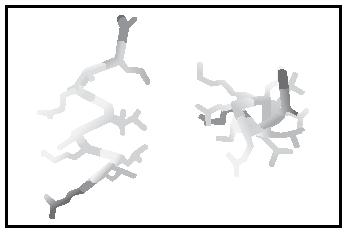Secondary Structure
The secondary structure refers to the conformation present at a local region of a polypeptide . A few types of secondary structure are particularly stable and occur widely in proteins. These include the α -helix and β -sheet conformations, which are both stabilized by hydrogen bonds . The α -helix is a rigid, rod-like structure that forms when a polypeptide chain twists into a helical conformation. Hydrogen bonds form between the amino (N–H) group of one amino acid and the carbonyl (C = O) group of the amino acid four residues away. The amino acid side chains extend outward from the helix. In the β -sheet, two or more polypeptide chains (or two or more portions of the same chain) are arranged side by side to form a sheet. Hydrogen bonds form between the backbone amino groups and the carbonyl groups of adjacent chains. The sheets are pleated, not flat, and the amino acid side chains of adjacent amino acids extend from the pleat structure in opposite directions. In a protein, loops or bends can connect the secondary structures.
SEE ALSO Primary Structure ; Tertiary Structure .
Elizabeth S. Roberts-Kirchhoff

Bibliography
Creighton, Thomas E. (1993). Proteins: Structures and Molecular Properties, 2nd edition. New York: W. H. Freeman.
Internet Resources
Gorga, Frank. "Introduction to Protein Structure." Available from http://webhost.bridgew.edu/fgorga .
Comment about this article, ask questions, or add new information about this topic: